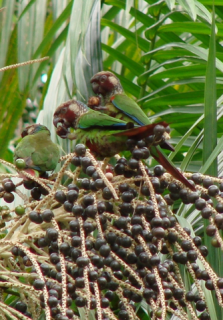White-eared Conure |
|
|
Also known as: White-eared Parakeet
Photos
View in GalleryDid You Know?
Pyrrhura conures have more swift, undulating flight, whereas Aratinga conures' flight is more straight and direct.Academic Research
Related publications: Pyrrhura leucotisSpecies Profile
Genus: Pyrrhura | Species: leucotis
Size:
23cm (9 in)
Weight:
50-53g (1.75-1.85 oz)
Subspecies including nominate:
one
Colour Adult:
Both adults mainly green; brown crown to nape, with strong blue wash on forecrown; hindneck with blue collar; brown/purple thin frontal band area around eyes and lores to upper cheeks; dull blue lower wash on cheeks; off-white ear coverts; green breast and throat with off-white and dark brown barring; brown/red centre of abdomen and patch on lower back to upper tail coverts; red bend of wing; maroon tail. Bill brown/grey. Eye ring pale grey/brown. Eye brown/orange.
Colour Juvenile:
In general duller than adults, with fainter barring on breast; red abdominal patch has scattered green feathers. Cere and eye-ring bare and grey/white.
Call:
Calls made in flight are sharp and rapidly repeated three or four times. Also a high-pitched, staccato series of notes, and occasional single notes when perched.
Listen NowVideo Links:
Video 1More Information:
Content Sources:
CITES
BirdLife International
Cornell Lab of Ornithology/Birds of the World
Parrots: A Guide to Parrots of the World, Juniper and Parr, 1998
ML Media Collection Catalogue 113308, White-eared Parakeet Pyrrhura leucotis, Marantz, Curtis, Espirito Santo, Brazil, Jan. 30 1999, Cornell Lab of Ornithology. Site
Parrots of the World, Forshaw and Cooper, 1989. 2010 edition
Parrots of the World, Forshaw, 2006.
Parrots in Aviculture, Low, 1992.
Lexicon of Parrots, Thomas Arndt.
Photos
View in GalleryDid You Know?
Pyrrhura conures have more swift, undulating flight, whereas Aratinga conures' flight is more straight and direct.Academic Research
Related publications: Pyrrhura leucotisSpecies Care
Captive Status:
Rare
Longevity:
Probably about 12-15 yrs.
Housing:
Aviary or suspended enclosure, minimum length 2m (6.5 ft).
Diet:
Fruits such as: apple, pear, banana, orange, cactus fruits, pomegrantate, mango, papaya, forming up to 30 percent of the diet; vegetables such as: carrot, celery, green beans and peas in the pod; fresh corn; green leaves such as: Swiss chard, lettuce, sowthistle, dandelion, kale, chickweed; spray millet; small seed mix such as: canary, millet, and smaller amounts of oats, buckwheat, safflower and a little hemp; soaked and sprouted sunflower seed; cooked beans and pulses, boiled maize and complete kibble.
Enrichment:
Are avid chewers so provide plenty of bird-safe, unsprayed branches of fir, pine, elder, willow or saskatoon; wooden block toys, vegetable tanned leather chew toys, push and pull toys, foraging/puzzle toys, swings, ladders and ropes. Also enjoys bathing so provide overhead misters or shallow water bowls.
Nest Box Size:
Vertical box 20cm x 20cm x 70cm (8 x 8 x 28 in).
Clutch Size:
3-8
Incubation Time:
20-24 days
Fledging Age:
42-48 days
Hatch Weight:
3-4g (0.1-0.15 oz)
Peak Weight:
Not recorded.
Weaning Weight:
Not recorded.
Photos
View in GalleryDid You Know?
Pyrrhura conures have more swift, undulating flight, whereas Aratinga conures' flight is more straight and direct.Academic Research
Related publications: Pyrrhura leucotisSpecies Wild Status
World Population:
15,000-30,000, decreasing.
IUCN Red List Status:
Vulnerable
CITES Listing:
Appendix II
Threat Summary:
Wild population is undergoing moderately rapid declines. Formerly occurred S to São Paulo and is described as generally scarce owing to extensive forest clearance; it now is locally fairly common in a few protected but widely scattered relict populations. Frequent confiscations in captivity suggest moderate levels of trapping.
Range:
E Brazil, from S Bahia south to Espirito Santo and E Minas Gerais, and formerly Sao Paulo; introduced to Rio de Janeiro Bontanical Gardens without success.
Habitat:
Found up to 600m (1968 ft) in forest, forest edge and adjacent clearings with scattered trees including naturally shaded cacao plantations and sometimes entering villages.
Wild Diet:
Feeds on seeds of Tapirira guianensis, Cecropia glazioui, C. pachystachya, C. hololeuca, Alchornea triplinervia, Pera glabata, Mouriri glazioviana, Ficus nymphaeifolia, F. gomelleira, F. guianensis, Eugenia cumini, Tremia micrantha, fruits of Cecropia glazioui, C. pachystachya, C. hololeuca, Ficus nymphaeifolia, F. gomelleira, F. guianensis, berries, nuts and possibly insects.
Ecology and Behaviour:
Social; usually seen in flocks of 15-20 individuals. Stays mainly in upper stages of canopy.
Clutch and Egg Size:
5-9 (captivity) broadly elliptical eggs, 26.5 x 20.5mm (1.0 x 0.8 in).
Breeding Season:
May-July.
Photos
View in GalleryDid You Know?
Pyrrhura conures have more swift, undulating flight, whereas Aratinga conures' flight is more straight and direct.Academic Research
Related publications: Pyrrhura leucotisMembers Only Resources
Please log-in now to find more research, resources and tools.
Not a Member?
Find more great information:
Gain exclusive access to 600+ pages of additional research, seminars and podcasts, specialists to ask your toughest questions, and dozens of other fun resources - when you become a WPT member.
Join Today >>

































